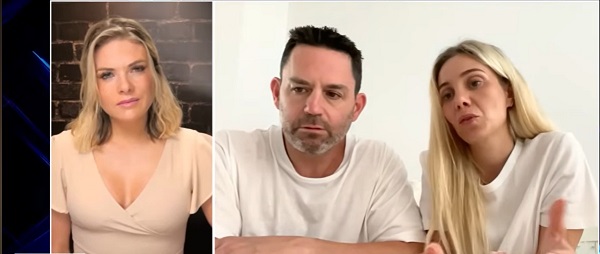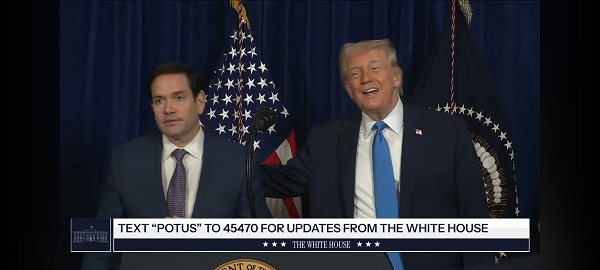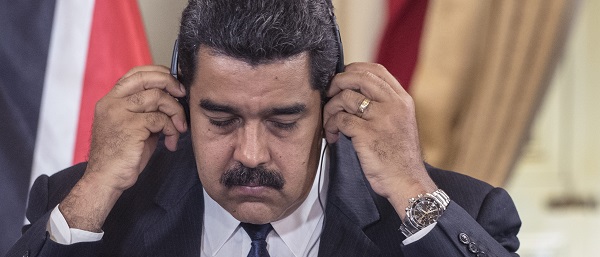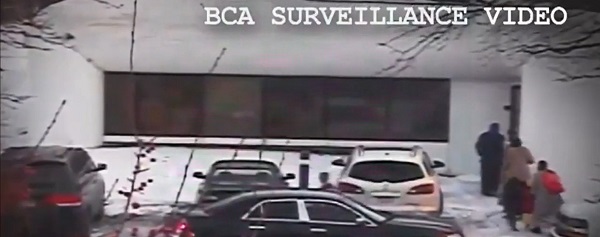Crime
The Bureau Exclusive: The US Government Fentanyl Case Against China, Canada, Mexico

Canadian federal police recently busted a massive fentanyl lab with evident links to Mexico and Chinese crime networks in British Columbia.
Canada increasingly exploited by China for fentanyl production and export, with over 350 gang networks operating, Canadian Security Intelligence Service reports
As the Trump Administration gears up to launch a comprehensive war on fentanyl trafficking, production, and money laundering, the United States is setting its sights on three nations it holds accountable: China, Mexico, and Canada. In an exclusive investigation, The Bureau delves into the U.S. government’s case, tracking the history of fentanyl networks infiltrating North America since the early 1990s, with over 350 organized crime groups now using Canada as a fentanyl production, transshipment, and export powerhouse linked to China, according to Canadian intelligence.
Drawing on documents and senior Drug Enforcement Administration sources—including a confidential brief from an enforcement and intelligence expert who spoke on condition of anonymity due to the sensitivity of the matter—we unravel the evolution of this clandestine trade and its far-reaching implications, leading to the standoff that will ultimately pit President Donald Trump against China’s Xi Jinping.
In a post Tuesday morning that followed his stunning threat of 25 percent tariffs against Mexico and Canada, President Trump wrote:
“I have had many talks with China about the massive amounts of drugs, in particular fentanyl, being sent into the United States—but to no avail. Representatives of China told me that they would institute their maximum penalty, that of death, for any drug dealers caught doing this but, unfortunately, they never followed through, and drugs are pouring into our country, mostly through Mexico, at levels never seen before.”
While Trump’s announcements are harsh and jarring, the sentiment that China is either lacking motivation to crack down on profitable chemical precursor sales—or even intentionally leveraging fentanyl against North America—extends throughout Washington today.
And there is no debate on where the opioid overdose crisis originates.
At a November 8 symposium hosted by Georgetown University’s Initiative for U.S.-China Dialogue on Global Issues, David Luckey, a defense researcher at RAND Corporation, said: “The production, distribution, and use of illegally manufactured fentanyl should be thought of as an ecosystem, and the People’s Republic of China is at the beginning of the global fentanyl supply chain.”
The Bureau’s sources come from the hardline geopolitical camp on this matter. They believe Beijing is attempting to destabilize the U.S. with fentanyl, in what is technically called hybrid warfare. They explained how Canada and Mexico support the networks emanating from China’s economy and political leadership. In Canada, the story is about financial and port infiltration and control of the money laundering networks Mexican cartels use to repatriate cash from fentanyl sales on American streets.
And this didn’t start with deadly synthetic opioids, either.
“Where the drugs come from dictates control. If marijuana is coming from Canada, then control lies there,” the source explained. “Some of the biggest black market marijuana organizations were Chinese organized crime groups based in Brooklyn and Flushing, Queens, supplied from Canada.
“You had organizations getting seven or eight tons of marijuana a week from Canada, all controlled by Chinese groups,” the source said. “And we have seen black market marijuana money flowing back into Canadian banks alongside fentanyl money.”
Canada’s legal framework currently contributes to its appeal for China-based criminal organizations. “Canada’s lenient laws make it an attractive market,” the expert explained. “If someone gets caught with a couple of kilos of fentanyl in Canada, the likelihood of facing a 25-year sentence is very low.”
The presence in Toronto and Vancouver of figures like Tse Chi Lop—a globally significant triad leader operating in Markham, Ontario, and with suspected links to Chinese Communist Party security networks—underscores the systemic gaps.
“Tse is a major player exploiting systemic gaps in Canadian intelligence and law enforcement collaboration,” the source asserted.
Tse Chi Lop was operating from Markham and locations across Asia prior to his arrest in the Netherlands and subsequent extradition to Australia. He is accused of being at the helm of a vast drug syndicate known as “The Company” or “Sam Gor,” which is alleged to have laundered billions of dollars through casinos, property investments, and front companies across the globe.
Reporting by The Bureau has found that British Columbia, and specifically Vancouver’s port, are critical transshipment and production hubs for Triad fentanyl producers and money launderers working in alignment with Mexican cartels and Iranian-state-linked criminals. Documents that surfaced in Ottawa’s Hogue Commission—mandated to investigate China’s interference in Canada’s recent federal elections—demonstrate that BC Premier David Eby flagged his government’s growing awareness of the national security threats related to fentanyl with Justin Trudeau’s former national security advisor.
A confidential federal document, released through access to information, states, according to the Canadian Security Intelligence Service (CSIS): “Synthetic drugs are increasingly being produced in Canada using precursor chemicals largely sourced from China.”
“Preliminary reporting by the BC Coroner’s Service confirms that toxic, unregulated drugs claimed the lives of at least 2,511 people in British Columbia in 2023, the largest number of drug-related deaths ever reported to the agency,” the record says. “CSIS identifies more than 350 organized crime groups actively involved in the domestic illegal fentanyl market … which Premier Eby is particularly concerned about.”
A sanitized summary on Eby’s concerns from the Hogue Commission adds: “On fentanyl specifically, Canada, the United States, and Mexico are working on supply reduction, including as it relates to precursor chemicals and the prevention of commercial shipping exploitation. BC would be a critical partner in any supply reduction measures given that the Port of Vancouver is Canada’s largest port.”
But before Beijing’s chemical narcotics kingpins took over fentanyl money laundering networks from Canada, the story begins in the early 1990s when fentanyl first appeared on American streets, according to a source with full access to DEA investigative files.
The initial appearance of fentanyl in the United States was linked to a chemist in Ohio during 1992 or 1993, they said. This illicit operation led to hundreds of overdose deaths in cities like Chicago and New York, as heroin laced with fentanyl—known as “Tango & Cash”—flooded the streets. The DEA identified and dismantled the source, temporarily removing fentanyl from the illicit market.
Fentanyl seemed to vanish from the illicit market, lying dormant.
The mid-2000s saw a resurgence, this time with Mexican cartels entering the methamphetamine and fentanyl distribution game, and individuals of Chinese origin taking up roles in Mexico City. “One major case was Zhenli Ye Gon in 2007, where Mexican authorities seized $207 million from his home in Mexico City,” The Bureau’s source said. “He was a businessman accused of being involved in the trafficking of precursor chemicals for methamphetamine production.”
Ye Gon, born in Shanghai and running a pharma-company in Mexico, was believed to be perhaps the largest methamphetamine trafficker in the Western Hemisphere. Educated at an elite university in China, he made headlines not only for his alleged narcotics activities but also for his lavish lifestyle. While denying drug charges in the U.S., he claimed he had received duffel bags filled with cash from members of President Felipe Calderón’s party—a claim that was denied by officials. His arrest also caused a stir in Las Vegas, where Ye Gon was a “VIP” high roller who reportedly gambled more than $125 million, with the Venetian casino gifting him a Rolls-Royce.
Despite high-profile crackdowns, the threat of fentanyl ebbed and flowed, never truly disappearing.
Meanwhile, in 2005 and 2006, over a thousand deaths on Chicago’s South Side were traced to a fentanyl lab in Toluca, Mexico, operated by the Sinaloa Cartel. After the DEA shut it down, fentanyl essentially went dormant again.
A new chapter unfolded in 2013 as precursor chemicals—mainly N-phenethyl-4-piperidone (NPP) and 4-anilinopiperidine (4-ANPP)—began arriving from China. This is when fentanyl overdoses started to rise exponentially in Vancouver, where triads linked to Beijing command money laundering in North America.
“These chemicals were entering Southern California, Texas, and Arizona, smuggled south into Mexico, processed into fentanyl, and then brought back into the U.S., often mixed with Mexican heroin,” the U.S. government source explained.
At the time, a kilo of pure fentanyl cost about $3,000. By 2014, it was called “China White” because heroin was being laced with fentanyl, making it far more potent. In February 2015, the DEA issued its first national alert on fentanyl and began analyzing the role of Chinese organized crime in the fentanyl trade and related money laundering.
The profitability and efficiency of fentanyl compared to traditional narcotics like heroin made it an attractive commodity for drug cartels.
By 2016, fentanyl was being pressed into counterfeit pills, disguised as OxyContin, Percocet, or other legitimate pharmaceuticals. Dark web marketplaces and social media platforms became conduits for its distribution.
The merging of hardcore heroin users and “pill shoppers”—individuals seeking diverted pharmaceuticals—into a single user population occurred due to the prevalence of fentanyl-laced pills. This convergence signified a dangerous shift in the opioid crisis, broadening the scope of those at risk of overdose.
The profitability for traffickers was staggering. One pill could sell for $30 in New England, and Mexican cartels could make 250,000 pills from one kilo of fentanyl, which cost around $3,000 to $5,000. This was far more lucrative and efficient than heroin, which takes months to cultivate and process.
This shift marked a significant turning point in the global drug trade, with synthetic opioids overtaking traditional narcotics.
By 2016, entities linked to the Chinese state were entrenched in Mexico’s drug trade. Chinese companies were setting up operations in cartel-heavy cities, including mining companies, import-export businesses, and restaurants.
“The growth of Chinese influence in Mexico’s drug trade was undeniable,” the source asserted.
Recognizing the escalating crisis, the DEA launched Project Sleeping Giant in 2018. The initiative highlighted the role of Chinese organized crime, particularly the triads, in supplying precursor chemicals, laundering money for cartels, and trafficking black market marijuana.
“Most people don’t realize that Chinese organized crime has been upstream in the drug trade for decades,” the U.S. expert noted.
When the COVID-19 pandemic hit in 2020, drug trafficking organizations adapted swiftly. With borders closed and travel restricted, cartels started using express mail services like FedEx to ship fentanyl and methamphetamine.
This shift highlighted the cartels’ agility in exploiting vulnerabilities and adapting to global disruptions.
By 2022, the DEA intensified efforts to combat the fentanyl epidemic, initiating Operation Chem Kong to target Chinese chemical suppliers.
An often-overlooked aspect of the drug trade is the sophisticated money laundering operations that sustain it, fully integrated into China’s economy through triad money brokers. Chinese groups are now the largest money launderers in the U.S., outpacing even Colombian groups.
“We found Chinese networks picking up drug money in over 22 states,” the source explained. “They’d fly one-way to places like Georgia or Illinois, pick up cash, and drive it back to New York or the West Coast.”
Remarkably, these groups charged significantly lower fees than their Colombian counterparts, sometimes laundering money for free in exchange for access to U.S. dollars.
This strategy not only facilitated money laundering but also circumvented China’s strict currency controls, providing a dual benefit to the criminal organizations.
They used these drug-cash dollars to buy American goods, ship them to China, and resell them at massive markups. Chinese brokers weren’t just laundering fentanyl or meth money; they also laundered marijuana money and worked directly with triads. Operations like “Flush with Cash” in New York identified service providers moving over $1 billion annually to China.
But navigating the labyrinth of Chinese criminal organizations—and their connectivity with China’s economy and state actors—poses significant challenges for law enforcement.
“The challenge is the extreme compartmentalization in Chinese criminal groups,” the U.S. expert emphasized. “You might gain access to one part of the organization, but two levels up, everything is sealed off.”
High-level brokers operate multiple illicit enterprises simultaneously, making infiltration and dismantling exceedingly difficult.
The intricate tapestry of Chinese fentanyl trafficking highlights a convergence of international criminal enterprises exploiting systemic vulnerabilities across borders. The adaptability of these networks—in shifting trafficking methods, leveraging legal disparities, and innovating money laundering techniques—poses a formidable challenge to Western governments.
The leniency in certain jurisdictions including Canada not only hinders enforcement efforts but also incentivizes criminal activities by reducing risks and operational costs.
As the United States prepares to intensify its crackdown on fentanyl networks, having not only politicians and bureaucrats—but also the citizens they are serving—understand the importance of a multifaceted and multinational counter strategy is critical, because voters will drive the political will needed.
And this report, sourced from U.S. experts, provides a blueprint for other public interest journalists to follow.
“This briefing will help you paint the picture regarding Chinese organized crime, the triads, CCP, or PRC involvement with the drug trade and money laundering—particularly with precursor chemicals and black market marijuana,” the primary source explained.
The Bureau is a reader-supported publication. To receive new posts and support my work, consider becoming a paid subscriber.
Crime
Brown University shooter dead of apparent self-inflicted gunshot wound

From The Center Square
By
Rhode Island officials said the suspected gunman in the Brown University mass shooting has been found dead of an apparent self-inflicted gunshot wound, more than 50 miles away in a storage facility in southern New Hampshire.
The shooter was identified as Claudio Manuel Neves-Valente, a 48-year-old Brown student and Portuguese national. Neves-Valente was found dead with a satchel containing two firearms inside in the storage facility, authorities said.
“He took his own life tonight,” Providence police chief Oscar Perez said at a press conference, noting that local, state and federal law officials spent days poring over video evidence, license plate data and hundreds of investigative tips in pursuit of the suspect.
Perez credited cooperation between federal state and local law enforcement officials, as well as the Providence community, which he said provided the video evidence needed to help authorities crack the case.
“The community stepped up,” he said. “It was all about groundwork, public assistance, interviews with individuals, and good old fashioned policing.”
Rhode Island Attorney General Peter Neronha said the “person of interest” identified by private videos contacted authorities on Wednesday and provided information that led to his whereabouts.
“He blew the case right open, blew it open,” Neronha said. “That person led us to the car, which led us to the name, which led us to the photograph of that individual.”
“And that’s how these cases sometimes go,” he said. “You can feel like you’re not making a lot of progress. You can feel like you’re chasing leaves and they don’t work out. But the team keeps going.”
The discovery of the suspect’s body caps an intense six-day manhunt spanning several New England states, which put communities from Providence to southern New Hampshire on edge.
“We got him,” FBI special agent in charge for Boston Ted Docks said at Thursday night’s briefing. “Even though the suspect was found dead tonight our work is not done. There are many questions that need to be answered.”
He said the FBI deployed around 500 agents to assist local authorities in the investigation, in addition to offering a $50,000 reward. He says that officials are still looking into the suspect’s motive.
Two students were killed and nine others were injured in the Brown University shooting Saturday, which happened when an undetected gunman entered the Barus and Holley building on campus, where students were taking exams before the holiday break. Providence authorities briefly detained a person in the shooting earlier in the week, but then released them.
Investigators said they are also examining the possibility that the Brown case is connected to the killing of a Massachusetts Institute of Technology professor in his hometown.
An unidentified gunman shot MIT professor Nuno Loureiro multiple times inside his home in Brookline, about 50 miles north of Providence, according to authorities. He died at a local hospital on Tuesday.
Leah Foley, U.S. attorney for Massachusetts, was expected to hold a news briefing late Thursday night to discuss the connection with the MIT shooting.
Crime
Bondi Beach Survivor Says Cops Prevented Her From Fighting Back Against Terrorists


From the Daily Caller News Foundation
A woman who survived the Hanukkah terrorist attack at Bondi Beach in Australia said on Monday that police officers seemed less concerned about stopping the attack than they were about keeping her from fighting back.
A father and son of Pakistani descent opened fire on a Hanukkah celebration Sunday, killing at least 15 people and wounding 40, with one being slain on the scene by police and the other wounded and taken into custody. Vanessa Miller told Erin Molan about being separated from her three-year-old daughter during Monday’s episode of the “Erin Molan Show.”
“I tried to grab one of their guns,” Miller said. “Another one grabbed me and said ‘no.’ These men, these police officers, they know who I am. I hope they are hearing this. You are weak. You could have saved so many more people’s lives. They were just standing there, listening and watching this all happen, holding me back.”
Dear Readers:
As a nonprofit, we are dependent on the generosity of our readers.
Please consider making a small donation of any amount here.
Thank you!
WATCH:
“Two police officers,” Miller continued. “Where were the others? Not there. Nobody was there.”
New South Wales Minister of Police Yasmin Catley did not immediately respond to a request for comment from the Daily Caller News Foundation about Miller’s comments.
Australian Prime Minister Anthony Albanese vowed to enact further restrictions on guns in response to the attack at Bondi Beach, according to the Associated Press. The new restrictions would include a limit on how many firearms a person could own, more review of gun licenses, limiting the licenses to Australian citizens and “additional use of criminal intelligence” to determine if a license to own a firearm should be granted.
Sajid Akram, 50, and Naveed Akram, 24, reportedly went to the Philippines, where they received training prior to carrying out the Sunday attack, according to the Australian Broadcasting Corporation. Naveed Akram’s vehicle reportedly had homemade ISIS flags inside it.
Australia passed legislation that required owners of semi-automatic firearms and certain pump-action firearms to surrender them in a mandatory “buyback” following a 1996 mass shooting in Port Arthur, Tasmania, that killed 35 people and wounded 23 others. Despite the legislation, one of the gunmen who carried out the attack appeared to use a pump-action shotgun with an extended magazine.
-

 Energy2 days ago
Energy2 days agoThe U.S. Just Removed a Dictator and Canada is Collateral Damage
-

 Haultain Research2 days ago
Haultain Research2 days agoTrying to Defend Maduro’s Legitimacy
-

 International2 days ago
International2 days agoU.S. Claims Western Hemispheric Domination, Denies Russia Security Interests On Its Own Border
-

 International2 days ago
International2 days agoUS Justice Department Accusing Maduro’s Inner Circle of a Narco-State Conspiracy
-

 International2 days ago
International2 days ago“It’s Not Freedom — It’s the First Step Toward Freedom”
-

 Daily Caller1 day ago
Daily Caller1 day agoTrump Says US Going To Run Venezuela After Nabbing Maduro
-

 Daily Caller1 day ago
Daily Caller1 day agoScathing Indictment Claims Nicolás Maduro Orchestrated Drug-Fueled ‘Culture Of Corruption’ Which Plagued Entire Region
-

 Business1 day ago
Business1 day agoVirtue-signalling devotion to reconciliation will not end well











